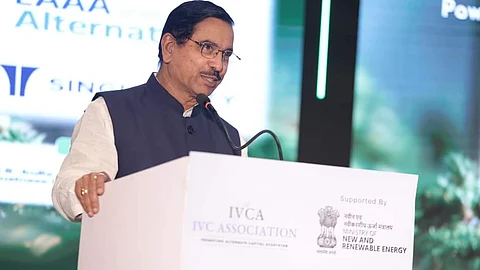

Mumbai: Solar power is now cheaper than conventional electricity in India, Union Minister for New and Renewable Energy Pralhad Joshi said on Tuesday, citing an 80 percent fall in solar tariffs over the years. “Clean energy is not only sustainable, but also more cost-effective than conventional sources,” Joshi said, addressing the inaugural IVCA Renewable Energy Summit in Mumbai.
The minister credited the shift to the government’s forward-looking renewable energy policies, which have positioned India as a global leader in the energy transition. Commenting on the same, Prime Minister Narendra Modi said in a post on X, “This illustrates India’s commitment and efforts towards building a green and sustainable future.”
India’s installed non-fossil fuel capacity has crossed 245 GW, including 117 GW of solar and 51.7 GW of wind, the minister said. “We have already surpassed 44 percent non-fossil fuel capacity, achieving the 2030 target five years ahead of schedule,” Joshi added.
In FY 2024–25 alone, the country added nearly 30 GW of renewable energy — the highest ever in a single year. Solar accounted for 23.83 GW of this addition, while cumulative wind capacity surpassed 50 GW. “This remarkable growth reflects our steady progress toward achieving 500 GW of non-fossil fuel capacity by 2030,” Joshi said.
India’s renewable energy sector is attracting unprecedented levels of capital. According to the MNRE, 83 percent of all power sector investments in 2024 were directed toward renewables, including USD 2.4 billion in global development finance. In the first quarter of 2025 alone, clean energy investments surged to USD 9.8 billion (Rs 81,700 crore), a 7.7-times increase year-on-year.
The minister highlighted the Rs 19,744-crore National Green Hydrogen Mission as a cornerstone of India’s energy strategy. The initiative aims to position the country as a global hub for hydrogen production, use, and exports. Other major projects mentioned included the 30 GW hybrid renewable energy park in Kutch and the largest waste-to-energy plant in Ahmedabad.
Joshi also underscored India’s push for self-reliance in clean energy manufacturing. Solar module production capacity has more than doubled, rising from 39 GW to nearly 91 GW, while solar cell capacity grew from 11 GW to 25 GW over the past year, the minister said.
Under the Pradhan Mantri Surya Ghar Muft Bijli Yojana, more than 15 lakh rooftop solar installations were completed in the past 12 months, benefiting over 16.5 lakh households, the minister noted.
The summit was attended by global and domestic investors, cleantech developers, regulators, and fund managers. Key dignitaries included former union minister Jayant Sinha, senior adviser to the IVCA Climate & Sustainability Council, and IVCA president Rajat Tandon.
